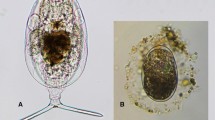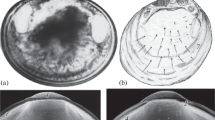Abstract
Ptilosarcus (Leioptilus) guerneyi (Gray) maintained in the laboratory, were observed to spawn in late March, 1972. Gametes, developed in the leaf proper, discharged through the mouths of feeding polyps and were fertilized externally in the sea water. The sea pen's eggs are 500 to 600 μ in diameter; a large female is capable of producing over 200,000 eggs in one season. A pear-shaped and free-swimming planula larva developed 4 days after fertilization, at a temperature of 12 °C. The larvae were ready to settle and metamorphose when 7 days old if favorable substratum was available, but would remain as planulae for at least 30 days if kept in glass dishes only. The 30-day-old larvae would metamorphose if a suitable substratum (coarse sand, for example) was presented. The larvae do not feed and, hence, development is lecithotrophic. Studies of histogenesis showed that metamorphosis greatly enhanced the rate of cellular differentiation. The high fecundity, lecithotrophic development, and the ability of substratum selection by the larvae explain the success of this species in maintaining a high-density population in many areas of sandy substratum in the shallow waters of Puget Sound (USA), despite the fact that it is preyed upon by 7 species of predators.
Similar content being viewed by others
Literature Cited
Birkeland, C.: Consequences of differing reproductive and feeding strategies for the dynamics and structure of an association based on the single prey species, Ptilosarcus guerneyi (Gray), Ph. D. Thesis, University of Washington 1969.
—, F. S. Chia and R. Strathmann: Larval development, delay of metamorphosis and growth of the starfish, Mediaster aequalis. Biol. Bull. mar. biol. Lab., Woods Hole 141, 99–108 (1971).
Chia, F. S. and M. A. Rostron: Some aspects of the reproductive biology of Actina equina (Cnidaria: Anthozoa). J. mar. biol. Ass. U. K. 50, 253–264 (1970).
— and J. G. Spaulding: Development and juvenile growth of the sea anemone, Tealia crassicornis. Biol. Bull. mar. biol. Lab., Woods Hole 142, 206–218 (1972).
Cloney, R. A. and E. Florey: Ultrastructure of cephalopod chromatophore organs. Z. Zellforsch. mikrosk. Anat. 89, 250–280 (1968).
Dunlap, H. L.: Oogenesis in Ctenophora, Ph. D. Thesis, University of Washington 1966.
Richardson, K. C., L. Jarrett and E. H. Finke: Embedding in epoxy resins for ultrathin sectioning in electron microscopy. Stain Technol. 35, 313–323 (1960).
Wilson, E. B.: Development of Renilla. Phil. Trans. R. Soc. 174, 723–815 (1883).
Wood, R. L. and J. H. Luft: The influence of buffer systems on fixation with osmium tetroxide. J. Ultrastruct. Res. 12, 22–45 (1965).
Author information
Authors and Affiliations
Additional information
Communicated by T. R. Parsons, Vancouver
Rights and permissions
About this article
Cite this article
Chia, F.S., Crawford, B.J. Some observations on gametogenesis, larval development and substratum selection of the sea pen Ptilosarcus guerneyi . Mar. Biol. 23, 73–82 (1973). https://doi.org/10.1007/BF00394113
Accepted:
Issue Date:
DOI: https://doi.org/10.1007/BF00394113




